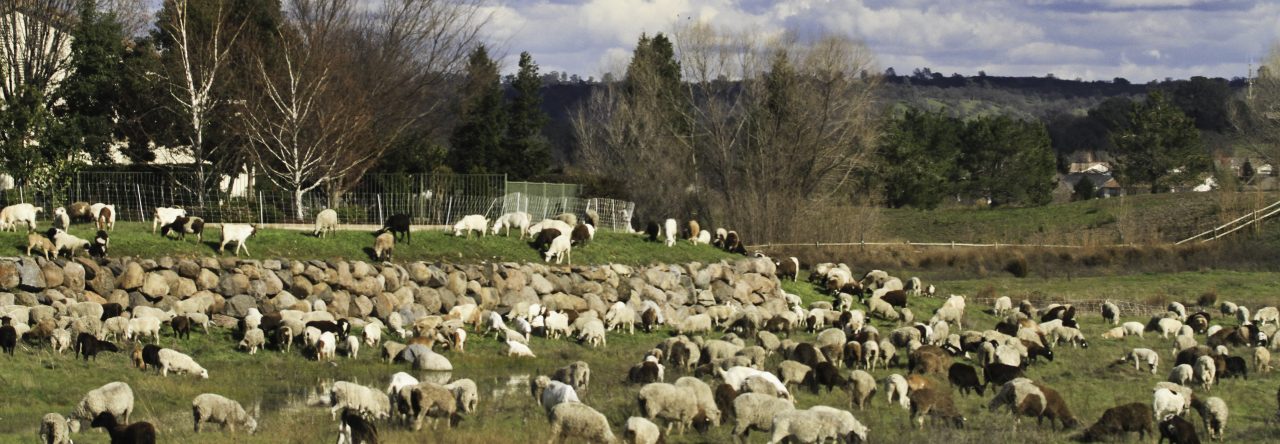In October of 2018 I had 650 early lamb pairs that needed quality forage to sustain milk production for strong lamb growth. I had wanted to try adding almond hulls within alfalfa grazing paddocks to assess impacts upon sheep for several years. Finding myself in a unique position, I decided to do a simple experiment. I rented 100 acres of older alfalfa that had significant grass intrusion for the 30 days of October. The 70 dollar per acre rent was expressed as the alternative net value to the farmer instead of harvesting the forage for baled hay.
As I prepared to move the sheep to the field I gave more thought to the use of almond hulls. I decided to add 100 pounds of hulls per acre as both a means of altering the sheep diet as well as increasing the number of days the sheep could stay within the 100 acres. The hay stand had a measured dry matter of 1000 pounds per acre, so the 100 pounds of hulls was hoped to increase the grazing period by 10 percent compared to feeding only green grassy hay.
The results were amazing. The sheep stayed an extra three days, but also gained weight and body condition during the 30-60 days of lactation cycle. Typical lactation in pure alfalfa stands creates heavy demand upon the stored body energy reserves that result in animals struggling to maintain weight ant condition. This is due to several factors, including a high protein ration, frothy bloat occurrence within the rumin from saponins, and diminished satiation/satiety time cycles.
After the 100 acres were grazed I elected to continue the hull program since the pairs were doing so well. I added hulls to a second band of animals grazing alfalfa during the same time interval in November. During one of the hull deliveries the crew ended up delivering 200 pounds per acre due to a communication failure on my part. After the initial disappointment I decided to do an additional study. I had an entire truck load of hulls delivered to the field. Since the truck was equipped with a set of scales I was able to place hulls in the bottom head land of the field in increasing tonnage. I started with 400 pounds per acre and increased to 1100 pounds per acre.
My idea was to see how much hull consumption the herd would comfortably sustain relative to green alfalfa. I found that the herd was willing to eat all the hulls, and so I don’t know where the upper threshold is. At 1100 pounds per acre the herd was eating roughly equal parts green hay and hulls. This derived a number of exciting thoughts and possibilities relative to soil function and the interaction between animal activities within alfalfa rotation cycles and soil health.
As I was doing the hull experiment I observed almond shell being spread within a nearby orchard. Since the orchard that was getting almond shells was farmed by a neighbor operation that I also graze upon, dialogue was generated to consider switching from hulls to shells during the 2019 fall grazing period. I asked the farmer to consider putting some almond shell on a few alfalfa fields after harvesting was complete for the season and prior to grazing the field with sheep. The results were even more rewarding than the hull trial.
The grower spread shell on several fields and we noted many positive outcomes both for the soil and the herd. The animals achieved better satiation and satiety outcomes, which resulted in less walking during rain events, and better growth and performance of the sheep.
Since the hulls contain certain minerals that benefit the soil in addition to the carbon inherit in shell tonnage I believe we are innovating a new era of system management relative to both soil and animal health and function.
I now hope to include several additional farmers as well as scientists/experts in doing more entailed data collections starting I fall, 2020to better understand how this activity is contributing to the obvious benefit of both the soils and animals. If we can increase the number of alfalfa growers as well as sheep and goat producers within this body of work, we will likely derive a highly functional method of increasing soil carbon levels that will enhance the water and carbon cycles that we very much need for healthy life.
Sincerely, Leland F Hazeltine

